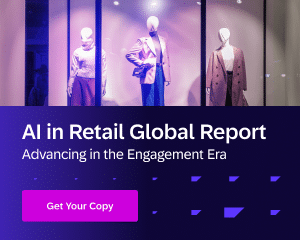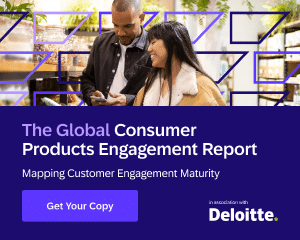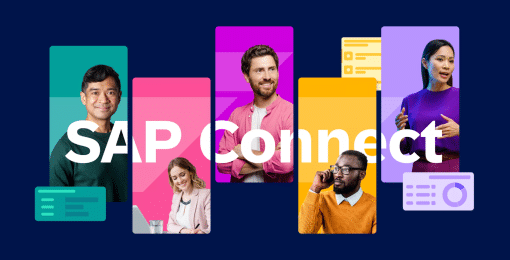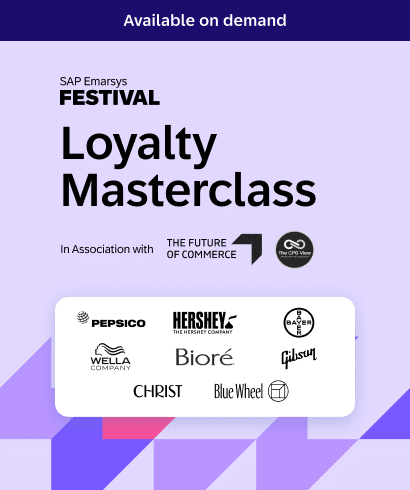It’s no secret that with skyrocketing acquisition costs and competitors looming at every corner waiting to tempt your audience away, customer loyalty has become the Holy Grail of sales and marketing. It stands to reason, loyal customers spend more, more often, and are resistant to competitors’ offers.
So, if you want to scale your business, maximize revenue, and increase customer loyalty, you need to create and deliver the kind of highly relevant, personalized customer experiences that turn fair-weather shoppers into loyal brand advocates.
But what is customer loyalty, why is it important, and how can brands foster more of it?
In this article, we’ll cover everything you need to know about this powerful retention strategy, complete with actionable advice on how you can start growing loyalty within your own customer base.
Why is Loyalty Important for a Business?
The SAP Emarsys Customer Loyalty Index 2024 found that 52% of respondents left a brand behind due to a bad experience. When it’s 5x easier to retain a customer than acquire a new one, numbers like these are hard to ignore.
This is why brands that focus on creating valuable experiences and stand-out service for their existing customers reap the rewards of repeat business and increased customer lifetime value.
In an over-saturated marketplace and tight economy where both brands and customers are feeling the pinch, loyalty matters more than ever.
How to Increase Customer Loyalty
Looking to increase your customer loyalty? Here are seven proven techniques that leading brands use to bridge the gap between them and their customers and grow long-lasting loyalty.
1. Invest in customer engagement technology
Batch-and-blast marketing is a thing of the past. If you want to attract, retain, and win loyal customers, you need to understand who they are and what they want. The key to making this happen lies in your data, but in order to use that data, you need the right technology.
By using a customer engagement platform, you can connect your product, sales and customer data from multiple sources into a single, holistic view of your customers, giving you the data you need to create a personalized, seamless customer experience.

2. Personalize your customers’ experience
45% of respondents in our research said they’ll use an app more often because of personalized messages. So, if you want to foster loyalty and keep your customers coming back time and time again, personalization is your new best friend.
Data powers personalization — and personalization drives loyalty. By taking the time to create tailored shopping experiences for your customers, you show that you understand them, helping to bring them closer to your brand and build trusted relationships.
By consolidating and leveraging your product, sales, and customer data, you have the information you need to elevate personalization beyond first names in subject lines and create relevant, meaningful experiences that drive repeat purchases and cultivate customer loyalty.
3. Remove friction from the customer journey
Nobody likes friction, least of all your customers. If you want to keep them coming back, exploring new product lines and recommending your brand to their friends and family, you need to make those processes as simple as possible.
You can cut down on friction in your customer journey by following these three steps:
- Map out your customer journey: Define your customer personas, and map out their paths to purchase across your core marketing channels.
- Track how customers engage across key touchpoints: Use marketing analytics and customer insight tools like Hotjar to gather data on how customers interact with your content.
- Identify areas for improvement: From emails to landing pages, highlight bottlenecks in your customer journey and create A/B split tests to work towards removing friction.
Decrease the friction in your user journey and you’ll increase engagement, acquisition, retention and customer loyalty.
4. Reward customers
Looking to strengthen your relationship with your customers and encourage repeat purchases? It could be as simple as rewarding them for shopping with you. Providing customers with rewards and perks for engaging with your brand is a proven strategy for enhancing customer loyalty and driving retention.
Try out the following incentives for your brand:
- Discount codes: Offer percentage or fixed amount off future purchases.
- Free products: Reward purchases with a free gift; for example, a complimentary item when a customer reaches a certain spending threshold.
- Exclusive access: Provide early access to new products or sales.
- Free shipping: Offer free shipping on the next order or for a limited time period.
- Loyalty points: Implement a points system where points can be earned with each purchase and redeemed for rewards.
- VIP experiences: Invite loyal customers to exclusive events or provide them with early access to sales.
- Birthday rewards: Give special discounts or free products on a customer’s birthday.
- Referral bonuses: Reward customers for referring friends who then make a purchase.
Personalization and automation takes this to the next level. By onboarding a customer engagement platform, you can tailor rewards to each customer based on key data points like Average Order Value, purchase frequency and product affinity, and automate them so they send out based on predefined triggers. The result? An always-on rewards strategy that makes your customers feel valued and understood on an individual level, giving them a compelling reason to return.
5. Prioritize customer service
Customer loyalty goes both ways — if you want to cultivate it, you need to show your customers that you’ve got their back when they need help or support.
Your customers have high expectations, but these expectations give you an invaluable opportunity to set yourself apart from competitors.
By focusing on a compelling, effective customer service strategy, you show your customers that you care about their business even when they aren’t 100% satisfied, and are committed to giving them a positive brand experience.
Delivering stand-out customer service is an investment, but lackluster customer service will cost your business more. In fact, studies show that half of consumers will consider buying from a competitor after just one poor customer service experience — with that number increasing to 80% if their next customer service interaction falls short, too.
When customer loyalty and long-term repeat business is at stake, investing time and resources in improving customer service is a small price to pay. Focus on making customer service a priority across all touchpoints, including social media, so you can engage your audience effectively, no matter where they need support.

6. Create a consistent omnichannel experience
57% of consumers say that high-quality products and memorable experiences positively impact their loyalty to a brand. Consistency creates trust, and trust leads to loyalty.
If you want to drive loyalty, you need to meet your customers on the channels they spend the majority of their time on.
This goes beyond simply being present on multiple channels – your content, brand and messaging needs to be consistent across all of them, too.
With the right personalization platform, you can create meaningful omnichannel engagements that drives sales, complete with marketing analytics to prove revenue contribution.
However, with multiple teams, freelancers and agency members working across your channels, this can be tricky to achieve. Create a set of Tone of Voice (TOV) and brand guidelines that govern the language and design themes that should be used throughout.
The result? Consistent cross-channel messaging, enriched with data that delivers a personalized experience – regardless of where your audience engages with you.
7. Ask for feedback and act on it
Customers are loyal to brands who understand them and are receptive to feedback. Your ability to collect, analyze, and action this feedback can be the make or break of your retention and loyalty strategy.
Some of the best places to gather feedback from your customers include:
-
- Email: Send out surveys via email to gauge customer satisfaction levels and identify key ways to improve them.
- Landing pages: Create feedback pop-ups on key customer touchpoints asking non-converters why they didn’t take action.
- Loyalty programs: Build feedback into your loyalty programs to gather feedback from your most loyal customers, offering them rewards in return.
- Live chat data: Use live chat analytics from platforms like Zendesk to surface customer feedback and improve satisfaction. Social listening: See what your customers are saying about your brand and its products online, and use this information to improve your offering.
Act on the feedback you receive and you won’t just improve your core metrics, you’ll also build a deeper understanding of your customers and build valuable trust.
8. Provide support post-purchase
Once the customer completes their purchase, your job is done, right? Right? Brands that stop their customer nurturing here are making a crucial mistake. Post-purchase support shouldn’t be an afterthought, because it’s an essential stage of the buyer journey that has a huge impact on retention, satisfaction and loyalty.
So, when that sales bell rings, don’t stop – stay in touch with your customers. Here are some ideas to help you keep the conversation going:
- Send post-purchase emails: Send thank-you emails, ask for feedback, or provide tips on how to best use your products. Personalize these emails based on the products your customers bought.
- Double down on customer service: Offer easy access to customer support to resolve any issues with the product or service quickly. Ensuring a hassle-free resolution process strengthens trust and reliability.
- Provide rewards and loyalty incentives: Use rewards and incentives to drive those all-important second purchases, and nudge your repeat customers towards your loyalty programs as a thank you for their business.
- Ask for feedback: Reach out to customers directly to gather insights on their purchase experience. This not only shows you care about their opinion but also helps you improve your products and services.
9. Build a community around your brand
Building a community around your brand is a powerful way to grow your customer engagement and deepen loyalty. By creating a space where customers can connect and interact with one another, you help to foster a sense of belonging and commitment, increasing your customers’ emotional attachment to your brand.
This can be achieved through various platforms such as social media groups, forums, or membership clubs where members can discuss products, offer advice, and provide feedback.
These community groups don’t only enhance the customer experience and foster loyalty – they also provide you with invaluable insights in the form of organic customer feedback that you can use to refine your strategy and improve your product offering.
7 Benefits of Customer Loyalty
While customer loyalty can take time to get right, loyal customers pay dividends once dialed in. From increased engagement to reaching previously-unidentified sales opportunities, here are six of the top benefits you can achieve by focusing on customer loyalty.
1. Builds emotional connections
In a world where your audience sees endless competitor ads and marketing campaigns every day, you need to think differently if you want to stand out.
This begins with switching focus from sales to loyalty and putting the customer at the center of your marketing strategy. By creating relevant content and engagements that go beyond simple discounts and incentives, you won’t just differentiate yourself from the hordes of competitors vying for your customers’ attention — you’ll build meaningful relationships that grab attention and build brand trust.
By creating these strong emotional connections with your customers, you’ll foster long-lasting loyalty that keeps them coming back.
2. Drives repeat business
Meaningful connections build brand trust, which is both a powerful sales driver and a robust defense against competitors.
In a digital world, your customer’s journey through the buying stages will occur across multiple channels — giving competitors the opportunity to swoop in and steal them away with targeted advertising and well-timed engagements. However, when customers have tangible, loyal connections to a brand that they trust, they circumvent the consideration phase and jump straight to conversion, often spending more.
This might be marketing theory, but it translates to practice, too. The numbers are there to back it up.
Customer loyalty research shows:
- Current customers spend 67% more than those that are new to a business.
- Loyal customers are 64% more likely to purchase more frequently.
- Loyal customers are 31% more likely to spend more per purchase.
So, whether it’s down to a positive customer service experience, an emotional brand connection or simply a stand-out product range that they can’t live without, customer loyalty is key to keeping customers coming back.
3. Increases Customer Lifetime Value (CLTV)
Most businesses agree that it costs 5x as much to attract a new customer as it does to retain a current one. In a climate where acquisition, manufacturing, and shipping costs are rising, this statistic is more relevant than ever.
This is where the power of customer loyalty really starts to shine.
Repeat customers who trust and are loyal to your brand are more likely to explore other product ranges that they might not have previously considered, as well as ordering their favorite products in increasingly large quantities.
This has a substantial impact on Customer Lifetime Value, as loyal customers both purchase more frequently and spend more than non-loyal customers who might return but are likely to purchase infrequently and in smaller quantities.
So, by nurturing customer loyalty, brands have a golden opportunity to dramatically increase the lifetime value of each customer, maximizing their revenue potential.
4. Reaches new customers with brand advocates
Work on customer loyalty, and your audience won’t just keep coming back themselves — they’ll bring their friends and family with them, too.
From relevant online engagements to stellar products and positive customer service interactions, create positive customer experiences and they’ll spread the news via word-of-mouth marketing.
Many people trust recommendations from friends and family more than online reviews, which means your biggest brand advocates can help you tap into new customer bases and attract buyers outside of your typical marketing reach. When 44% of loyal customers are willing to recommend your business to friends and family, that’s a lot of new potential customers.
Pro tip: Turn customers into brand advocates and drive more referrals with targeted incentivization. Build referral offers into your loyalty program with rewards that unlock at different stages, and add referral offer blocks into emails sent to repeat customer segments.
5. Provides you with a competitive advantage
Getting first-time customers to return to your store instead of taking competitors for a spin is a challenge that many marketers lose sleep over. However, keeping first-time customers coming back couldn’t be more important.
Studies have shown that even a 5% increase in customer retention can increase revenue by 25-29%. With today’s marketers being pushed to deliver more results with less budget, numbers like these are hard to ignore.
Loyal customers stay around longer — and spend more per transaction. With this consistent, steady cash flow, you get the stability you need to scale your customer acquisition strategy and win more market share.
6. Improves resilience to market volatility
Modern customers are fickle. They’re also very price-sensitive. Unfortunately, while it’s an undeniable fact of human behavior, it can also spell disaster for your business in the wrong circumstances.
In the event of economic downturns and depreciating market conditions, your business can find itself in hot water fast, forced to cut margins and offer deep discounts to keep customers coming back.
Loyalty helps you hedge against this. Not only are loyal customers less likely to be swayed by cost, they’re also much more likely to keep shopping with your brand even if your prices have to increase to cover tough market conditions.
7. Loyal customers spend more, more often
The value of a loyal customer goes beyond their immediate financial contributions. These customers tend to make more frequent purchases, have higher lifetime value, and provide invaluable insights through their engagement. The long-term relationship they build with a brand helps businesses achieve stability, reduce churn, and create sustainable growth.
Additionally, loyal customers often display “True Loyalty”—emotional connections that surpass transactional benefits. This loyalty leads to a stronger bond between the customer and brand, resulting in advocacy and referrals, which have a compounding effect on business growth.
How SAP Emarsys helps: Emarsys’s data analytics can quantify the true value of your loyal customers by analyzing key metrics like customer lifetime value, repeat purchase rate, and referral impact. This allows brands to understand not just how much a customer spends, but the potential long-term impact they bring. By leveraging Emarsys’s AI-driven insights, businesses can fine-tune their loyalty strategies, ensuring they maximize the value from each loyal customer.
Measuring Customer Loyalty and Retention
If you want to optimize your loyalty strategies and understand the impact they’re having on your revenue, accurate measurement and analytics are absolutely essential.
Loyalty solutions like Emarsys give you the tools and integrations you need to track, analyze and improve these key metrics:
- Unified data: Emarsys integrates data from all sources to give you a complete view of your customer, enabling more precise measurement and adjustments.
- Comprehensive reporting: Track real-time customer interactions and engagement across channels to understand the impact of loyalty programs and campaigns.
- Customer behavior insights: Use AI-driven analytics to monitor purchase patterns, predict churn, and identify high-value customers.
- Custom reporting: Generate detailed reports on loyalty program performance, campaign ROI, and customer lifetime value (CLV).
- Optimize campaigns: Analyze customer responses to refine targeting, improve retention strategies, and maximize loyalty program effectiveness.
5 Key metrics for assessing loyalty
Measuring customer loyalty goes beyond simply looking at sales. By tracking the right metrics, you can truly understand how engaged and committed your customers are to your brand. Here are some key metrics you should keep an eye on, and how Emarsys makes it easier to track them:
- Customer Lifetime Value (CLV): CLV tells you how much revenue a single customer is expected to bring over their entire relationship with your business. This is essential for understanding the long-term benefits of building loyalty. With Emarsys, you can easily track CLV by integrating data from all your channels, giving you a complete picture of customer value over time.
- Churn Rate: No one likes to see customers leave, but keeping an eye on your churn rate—the percentage of customers who stop engaging with your brand—helps you spot problems early. Emarsys helps you reduce churn by using predictive analytics to identify at-risk customers and target them with personalized retention strategies.
- Repeat Purchase Rate: This metric is simple but powerful—it shows how often customers come back to make additional purchases. If you’ve got a high repeat purchase rate, it’s a great early indicator that your loyalty and retention efforts are paying off. Emarsys makes it easy to track this, while also helping you encourage repeat purchases through personalized campaigns.
- Loyalty program engagement: One of the best ways to measure loyalty is through how often customers redeem rewards in your loyalty program. If customers are actively engaging with your rewards, it’s a good sign they’re invested in your brand. Emarsys automates loyalty programs and provides in-depth analytics, making it easy to see how engaged your customers are.
- Customer Engagement Score: Finally, understanding how engaged your customers are across all touchpoints—whether it’s through email, your website, or your app—is key to assessing loyalty. Emarsys offers a complete engagement score that helps you track interactions and fine-tune your strategy to keep customers coming back.
Keep tabs on these metrics with a platform like Emarsys, and you’ll gain real insights into customer loyalty that allow you to make smarter, data-driven decisions that strengthen relationships and drive growth.
Customer Loyalty Success Stories
Looking for inspiration for your brand’s loyalty initiatives? Take a look at these success stories and find out how AO, Petco and City Beach used personalization to build loyalty at scale:
AO boosts retention through personalization

Challenge: AO, the UK’s biggest online electrical retailer, struggled with customer retention, especially during long sales cycles. They needed a sure-fire way to engage both first-time and returning buyers more effectively.
Solution: Using Emarsys’ AI-powered platform, AO implemented personlized campaigns targeting customers at various stages of the buying cycle, delivering timely and relevant content that resonated with individual behaviors and preferences.
Results:
- +14% Opt-in Database Growth from Emarsys Web Channel
- +150% Newsletter Email Engagement (click-to-open)
- 45% of revenue driven by automation
- +12% Average Order Value
Petco keeps pet lovers coming back

Challenge: Petco, a leader in pet health and wellness, wanted to connect its loyalty program across online and offline channels to offer more seamless experiences and increase customer retention.
Solution: Emarsys integrated Petco’s customer data, enabling personalized omnichannel experiences through email, web, and mobile, while automating loyalty program engagement.
Results:
- +20% increase in revenue from active customers within 90 days
- 15% increase in won-back customers
- 31% increase in revenue overall
- ~300X return on ad spend
City Beach builds omnichannel loyalty

Challenge: Australian fashion retailer City Beach faced difficulties in delivering consistent experiences across its physical and digital channels, which hindered customer loyalty.
Solution: City Beach used Emarsys to connect its online and in-store experiences with personalized, data-driven marketing campaigns that engaged customers across key touchpoints.
Results:
- +10% increase in average order value on loyal shoppers vs non-loyal shoppers
- 35% open rate for loyalty campaigns
- +34% increase in customer purchase frequency
- 7.4% conversion rate for loyalty campaigns
Elevate Your Business with Loyal Customers
Cultivating loyal customers is about more than driving more sales—it’s about building a community that believes in your brand. By implementing the innovative strategies and technologies discussed, you can drive customer engagement, grow satisfaction, and cultivate true loyalty.
Ready to see the difference omnichannel marketing can make to your customer loyalty, retention and revenue? Book a demo with Emarsys today.







